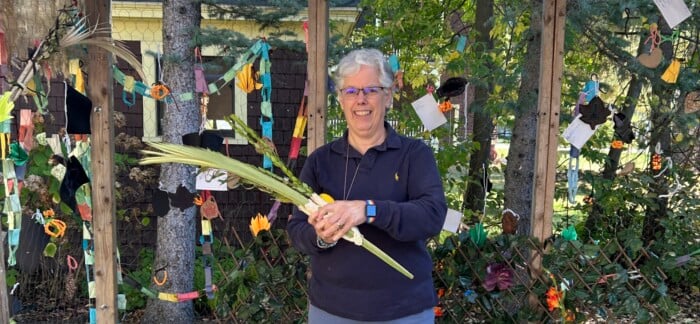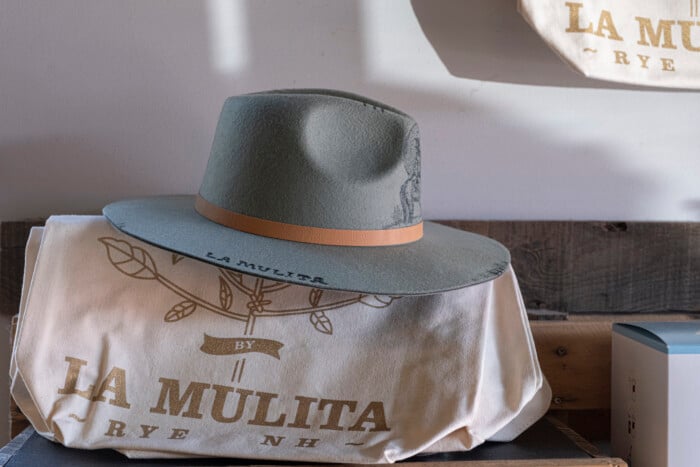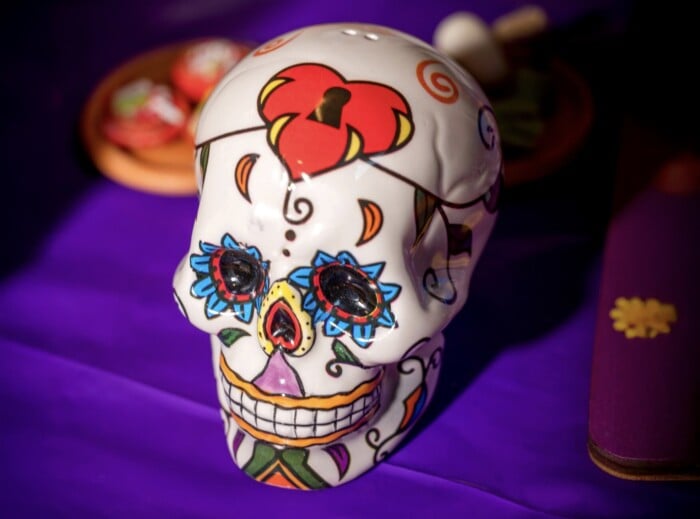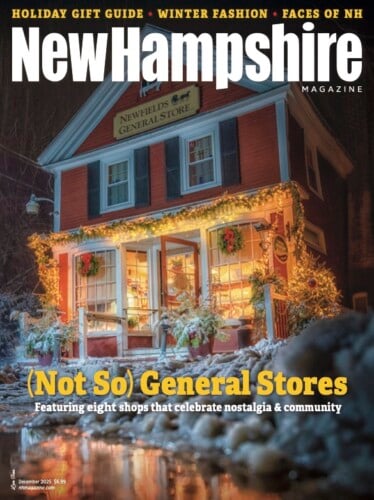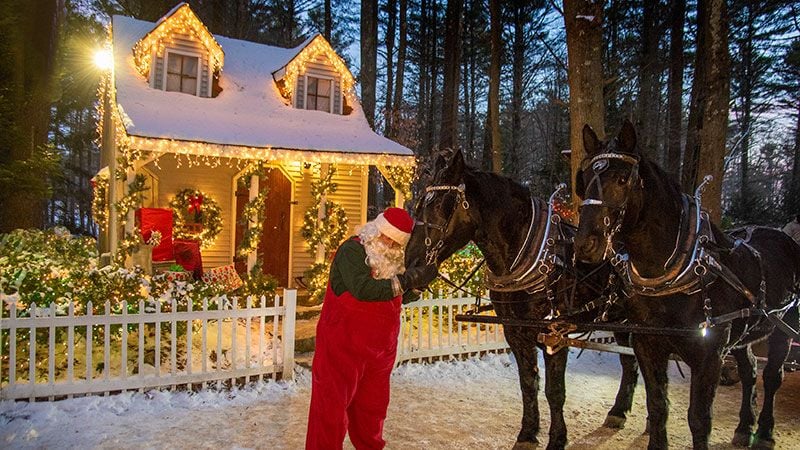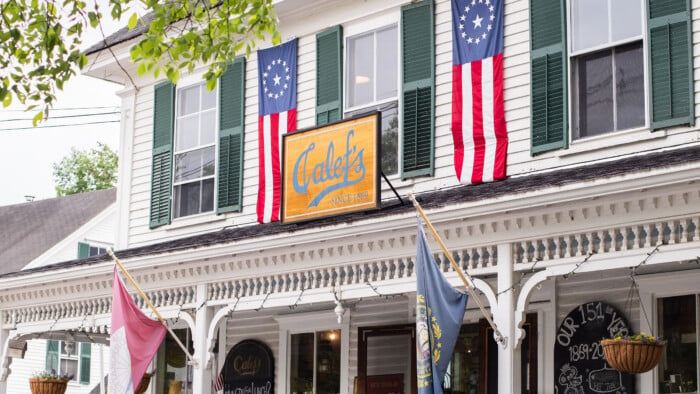Roller Derby Offers Welcoming Teams for All Identities
Trans skaters find a place in roller derby

Keisha “Gnarwen” Evans and Ashlee “TuckHerUp” Tucker from Rock Coast Roller Derby and two members of Green Mountain Roller Derby
On a Wednesday night in Manchester’s JFK Memorial Coliseum, nearly two dozen roller skaters huddle in the middle of the rink. One skater gives an encouraging pep talk to her team, all clad in tank tops, jerseys and protective sports gear.
Though the skaters are sweating and bruised after two hours of practice, she coaxes a cheer from them: “Skate free or die!” the group yells in unison, their words reverberating around the rink.
The team’s members comprise a range of ages, occupations and gender identities. But it’s flat-track roller derby — a contact sport on roller skates — bringing them all together as the New Hampshire Roller Derby.
The league, a Manchester-based nonprofit, is one of several such teams in the Granite State creating a thriving community where both cisgender and transgender people voluntarily and amicably play a sport together. Others are the Granite State Roller Derby in Concord; Monadnock Roller Derby; and Twin State Derby, representing New Hampshire and Vermont communities in the Upper Valley area.
“I was the kid holding onto the wall in the skating rink, and then I started as an adult with two kids and was like, ‘OK, I can do this,’” said Bekah Kistler, 43, of the Greater Manchester area, who is known to her teammates as “Penalty Bex” — her player name, inspired by an element of the sport.
Kistler, who is cisgender, began playing roller derby in 2010 after a friend invited her into the scene. She says she originally got invested because of the sport’s active energy for adults, and later found social belonging in her team. Kistler says she became acquainted with trans and queer people through her involvement in derby and has become a strong ally thanks to this.
“When we get here, we all work as a team,” Kistler said. “There’s a space for everybody in every shape and size, and we find a way to capture the benefits of each skater. It’s just like a family.”

In that sense, trans players say derby gives them an outlet to be both athletic and freely express their gender, without facing an atmosphere of scorn for their identities that has emerged in some sporting communities due to perceptions of gender-diverse people.
Saoirse Cogan initially hesitated to join roller derby due to this. Cogan, 36, now plays for Granite State Roller Derby as “SershaSaurus,” which she said helps announcers and spectators understand how to pronounce her first name.
“It was immediately very obvious that it was going to be an open and accepting place,” said Cogan, who is transgender. “I think one of the biggest encouragements was to find that I wasn’t the first trans skater in our league. It was a real reassurance to show up to one of my first practices and see another trans girl there who was a very skilled skater and to see her really be able to excel with the group.”
In flat-track roller derby, two teams compete for more points than the other on an oval-shaped track. Basic derby games, or bouts, are divided into two 30-minute periods, according to the Women’s Flat Track Derby Association (WFTDA), an international governing body of the women’s form of the sport.

Renee “Hexadecimate” St. Louis, a jammer for Bay State Brawlers.
Those 30-minute periods are subdivided into two-minute segments called “jams,” where the two opposing teams send out five skaters — collectively known as a “pack.” Four pack members are “blockers” and the remaining player is a “jammer.” The jammer on each team starts a jam behind the blockers and scores a point for every opposing blocker they make a skating lap around during each lap.
Jammers start behind the pack, and they must navigate through it and skate around the track to score points on opposing blockers. Then, there’s a 30-second break in between each jam. Flat-track derby is a full-contact sport, and generally, skaters can only use their hips, shoulders and upper arms to contact opponents. Those who make unsafe or illegal plays may receive a penalty, resulting in a 30-second removal.
Research on transgender participation in sports is ongoing in the U.S. and abroad, with one recent cross-sectional study by scholars in the United Kingdom, Spain and Italy indicating trans athletes may be at a physical disadvantage compared to cisgender athletes. The study, funded by the International Olympic Committee (IOC) and published in April in the British Journal of Sports Medicine, examined the athletic competence of 35 trans athletes who had undergone gender-affirming hormone therapy and 40 cis athletes. Participants in both groups were actively in competitive sports or physical training three times weekly.

Belinda “Sargent Bruiser” Jenkins and Magin “Pumpkin Slice” Belliveau, from the Shoreline Roller Derby team.
The study found that trans women performed worse than cis women in tests of lower-body strength and lung function and that trans women had a bone density — which is linked to muscle strength — equivalent to that of cis women. The study noted, however, that trans women had greater right handgrip strength than cis women.
Trans participation in sports has hit roadblocks in New Hampshire as the state recently passed a bill preventing middle and high school transgender girls from being included in school-sanctioned girls’ athletics. New Hampshire is the first state in the Northeast to impose such a restriction.
Most New Hampshire leagues are members of WFTDA, as the groups are catered toward women or feminine-expressive players. Co-ed and men’s derby also exist, with many men’s teams internationally governed by the Men’s Roller Derby Association (MRDA). However, no men’s leagues presently exist in New Hampshire, with the nearest MRDA groups in Portland, Maine, and Northampton, Massachusetts.
Neither WFTDA or MRDA requires transgender players to undergo any length or type of hormone therapy.
“Derby has not only the ethos of the sport being more inclusive, but the technical aspects of the sport are very inclusive as well,” Cogan said. “Every different body type has a different form of skating that favors them, and they’re all valuable on the track. Whether you’re 6’3”, or 4’4” or somewhere in the middle like me at 5’4”, we all have a role that we can excel in.”

New Hampshire Roller Derby skater Jena “Pixie Bruiser” McClary, center, is joined on the rink by husband Mark McClary, who is the head coach of New Hampshire Roller Derby and a Casco Bay player
While there may be gendered associations that set standards for different types of roller derby, the sport as a whole doesn’t limit who can be in which leagues based on their identity, attracting gender-nonconforming players.
It’s an aspect that Katherine Skipper, 36, of Keene, takes solace in as a genderfluid person.
Skipper, whose pronouns are she/they, plays on Monadnock Roller Derby, under the alias of “Criminal Wrecker” and wheeled into the derby scene in 2011 in the Northampton league — Pioneer Valley Roller Derby — which remains active.
“I identified as a cis woman until pretty recently, so that was not a thing for me back then,” she said. “Knowing that I have this beautiful supportive community of people who are fine with however I express myself is invaluable.”
They said their favorite quality of roller derby is that the sport welcomes those with or without a history of athleticism.
“It draws in people who were not the jocks in high school but the misfits,” she said. “It really is an island of misfit toys — the people who thought they would never be athletic and they would never be in team sports. We get a lot of people who don’t have an athletic background, don’t really know how to skate or have not gotten to experience the camaraderie and joy of team sports.”

New Hampshire Roller Derby skaters Avery Roy, alias Pell-Mel, left, and Kelsea Thomaier, known as Terror Nova, right, close in on each other amid a derby bout against Maine’s Casco Bay Roller Derby.
Avery Roy, a 31-year-old trans woman in Manchester, might just be one of those misfits. A relative newcomer to derby, she’s been with NH Roller Derby for about a year and had only ever roller skated for about six months before then.
“I never fit in with team sports; it just didn’t feel good or comfortable, so I think it’s very surprising to be finding this community now at this point in my life,” said Roy, known as “Pell-Mell” to her teammates. “I was involved in some sports as a child, but that wasn’t something I wished to do. I remember several years of Little League (baseball) in which I was generally bored and not involved with things that were happening in the outfield.”
Conversely, 37-year-old Janelle Ellison, of Lowell, Massachusetts, was less out of place in high school sports, saying she was “pretty gifted with athletics.”
“I credit athletics as probably the only reason I was able to survive through high school,” said Ellison, who plays with NH Roller Derby occasionally and is currently vice president of its governing board. “I was that freshman on the varsity team, so I was able to be a little bit more protected because I had upperclassmen insulate me from the regular high school mentality.”
Twin State Derby skater Grace Alden, 54, said that for trans people like herself the community around roller derby can be pivotal to boosting one’s self-worth.
“With the amount of rejection we encounter in many other parts of our lives, having a group of people who welcome you for who you are as a person — not for what you are — can bring in shared company and kindness and mutual support, and it’s tremendous,” Alden said.
More simply, she says, “It can be lifesaving.”
This article is featured in the fall 2024 issue of 603 Diversity.
603 Diversity’s mission is to educate readers of all backgrounds about the exciting accomplishments and cultural contributions of the state’s diverse communities, as well as the challenges faced and support needed by those communities to continue to grow and thrive in the Granite State.


